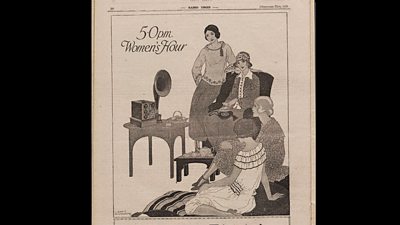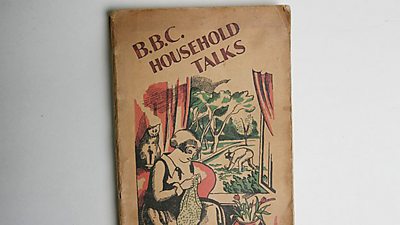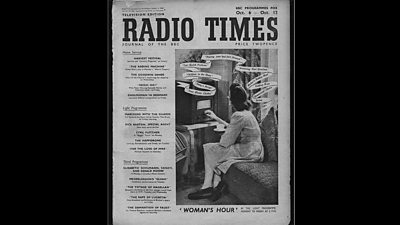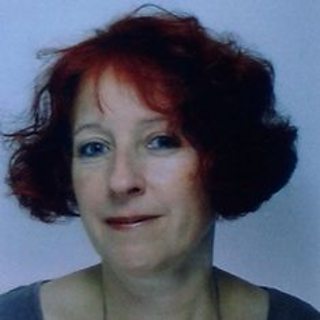The BBC has a long history of programmes for women - exemplified by the survival of Radio 4's Woman's Hour, still on air after more than 70 years. Women's television, as a distinct entity, reached its peak in the 1950s and early 1960s, but the roots of women’s programming date back to the 1920s. So what was distinctive about the BBC’s approach?
It is no surprise that the BBC of the 1920s and 1930s created bespoke daytime programmes for women. This was an era when a married woman’s place was firmly in the home.
In May 1923, in awareness of this captive daytime audience, the BBC launched Women's Hour (not to be confused with today's Woman's Hour), a daily programme of talks on topics as wide ranging as poultry keeping, infant care, local government, fashion, and engineering as a career, which reflected both the diversity of its listenership and the BBC’s aim to educate and inform.

Women's Hour as an entity was short-lived. Overseen by an Advisory Committee of eminent women, the title was abandoned in March 1924, revealing tensions that surrounded the identification of women as "other", as having distinctive needs - something that is still debated today.
Yet talks aimed at women did continue. They were redesignated Household Talks in 1927 and Morning Talks in 1929.

Hilda Matheson, Director of Talks from 1927-1932, had no doubts about the important role these programmes played in women’s lives. As well as domestic advice they offered stimulation and a chance of escape, "a preparatory course to help them to catch up, to feel less at a disadvantage, to keep abreast of wider interests". For instance, she launched The Week in Westminster in 1929 (still on BBC Radio 4 today) as a way of informing newly enfranchised women about the workings of the UK's parliament.
Elise Sprott, who worked with Matheson, joined the BBC in 1925 as both an occasional presenter and a producer of women’s talks. In 1932 she recreated a cookery talk as part of a programme that looked back to the early days of Savoy Hill, the BBC’s first home:
Elise Sprott, like her successors in the 1930s, Margery Wace and Janet Quigley, produced talks that spoke to female listeners as housewives and mothers, but also as intelligent women interested in the world around them. This focus shifted somewhat during the Second World War.
Under Quigley's editorship, a range of talks and magazine programmes were produced which were aimed not only at women in the home but also in the factory and in the forces.
These talks were an important part of the BBC's wartime mission to provide news and information but also to maintain morale.


Following in this long tradition of women's programming, in October 1946 the BBC launched Woman's Hour. Norman Collins, who was Head of the Light Programme at the time of its launch, is credited with having the idea, as he explained when he was a Guest of the Week on Woman's Hour in 1967.
Woman’s Hour was soon attracting a listenership of several millions. Like its predecessors, it spoke to women both in their domestic role, but also as citizens.
And it was not shy of tackling sensitive subjects. Olive Shapley presented the programme in the late 1940s. Speaking on a Northern edition of the programme in 1976, she recalled a controversial item on the menopause, and the reaction that it provoked:
As Shapley highlights, central to Woman's Hour was its close relationship with listeners, something that set it apart from other radio programmes at this time.
Monica Sims also discusses this in her newly released interview with Frank Gillard for the BBC Oral History Collection. Sims, who joined Woman’s Hour as a young producer in 1953, spoke also about the challenges of its production:
Sims would return to Woman's Hour as Editor in 1964. In her interview with Frank Gillard she reiterated the pioneering nature of the programme, the breadth of items and the sensitivities of the listener:
Another Woman's Hour producer/presenter in the 1960s was Gillian Hush, who worked on the North Regional edition of the programme, mainly from the BBC's Durham office.
Her interview for the BBC's Oral History of North Regional Broadcasting reveals how being away from London made a difference to the programme and how it was produced:
Woman's Hour was not the only BBC programme for women at this time.
Taking its lead from radio, in 1947 the newly established post-war TV service launched the afternoon programme Designed for Women. A mix of domesticity, information and escapism, this was followed by About the Home and Leisure and Pleasure in 1951.
Then, in 1953, the BBC appointed Doreen Stephens as Editor of its newly established Women's Programme Unit. Stephens, who had a background in political activism, was determined to address her female audience as citizens, so combining their private and public roles, and she introduced a raft of ambitious programming under the banner Mainly for Women.
It was to Doreen Stephens' small team that Monica Sims was transferred in 1956, and it was where she would work for eight years.
As she told Frank Gillard, she was eager to work in this "new exciting glamourous medium of television":
Although the audience figures were generally good, and the programmes were well received, they largely went unnoticed by BBC management, as Sims recalled:
The Women's Programme Department in Television was shut down in 1964. It was amalgamated with Children's Programmes to form the Family Programmes Department which subsequently closed in 1967.
Television would continue to address its female audience, but not within a distinctively gendered strand. Instead series like the long running Pebble Mill at One (1972-1996) took on this role.
In 1990, Woman's Hour ran a vociferous campaign to retain its identity and its name. It remains the longest running radio programme for women in the world.
Written by Dr. Kate Murphy, Bournemouth University.
With thanks to Dr. Kristin Skoog, Dr. Mary Irwin, Dr. Rachel Moseley, Dr. Helen Wheatley and Professor Helen Wood.

